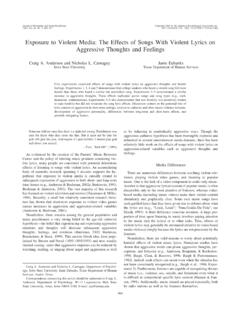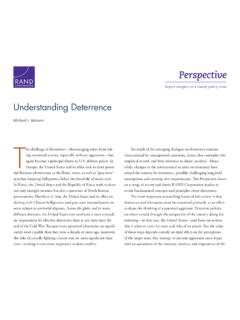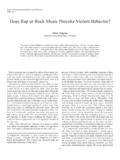Transcription of Model Guidelines - Managing and Responding to Threats ...
1 Model Guidelines - Managing and Responding to Threats , aggressive Behaviour and Violence from Members of the Public June 2014 Acknowledgements This guideline has been developed with reference to NSW Ombudsman office policies, and equivalent policies from other public sector agencies: in particular, NSW Housing s Policy and procedures for the prevention and management of aggressive behaviour (2001); the former NSW RTA s Managing aggression and violent behaviour at work (2002); NSW Parliament s Guidelines for preventing and Managing client aggression in electoral offices (2001); and Centrelink s Dealing with customer aggression (2001).
2 NSW Ombudsman Level 24, 580 George Street Sydney NSW 2000 General enquiries: 02 9286 1000 Facsimile: 02 9283 2911 Toll free (outside Sydney Metro Area) 1800 451 524 Telephone typewriter: 02 9264 8050 Email: Web: ISBN: 978-1-925061-31-4 Crown Copyright, NSW Ombudsman, June 2014 This work is copyright, however material from this publication may be copied and published by State or Federal Government Agencies without permission of the Ombudsman on the condition that the meaning of the material is not altered and the NSW Ombudsman is acknowledged as the source of the material. Any other persons or bodies wishing to use material must seek permission.
3 2 Table of Contents Introduction .. 4 Purpose .. 4 Responsibility .. 4 Related policies and Guidelines .. 5 Definitions .. 5 Principles .. 5 Model Guidelines .. 7 1. Responding to anger .. 7 2. Responding to aggressive phone calls .. 8 3. Responding to Threats , aggressive behaviour and violence .. 9 4. Responding to mail and bomb Threats .. 10 5. Responding to Threats with a weapon .. 11 6. Referrals of Threats to self or third parties .. 11 7. Security in public contact areas .. 12 8. Admission of visitors to secure premises .. 13 9. Interviewing members of the public .. 13 10. Use of duress alarms .. 16 11.
4 Inappropriate written correspondence, including 17 12. Post incident 17 13. Reporting Requirements .. 19 14. Restricting access or imposing alternative service arrangements .. 19 Annexures Annexure A - Security arrangements and equipment .. 23 Annexure B - Security incident report form .. 24 Annexure C Tips for Responding to Threats , aggressive behaviour and violence .. 25 Annexure D Orders to address violence, Threats , intimidation and/or stalking .. 26 Annexure E - Restricting access/entry to our premises .. 28 Annexure F Special precautions for mail handling .. 30 Annexure G Bomb Threats .. 31 Annexure H Threats with a weapon or hostage situations.
5 32 Annexure I - Debriefing .. 33 Annexure J - Matters to consider when conducting a risk assessment of public areas .. 34 Annexure K Physical security at reception/waiting areas .. 35 3 Model G uidelines - Managing and Responding to Threats , aggressive behaviour and violence from members of the public Introduction One of the most intriguing things about us is our diversity. Not only do we look different, sound different, come from different backgrounds and a range of experiences, we can also react very differently in certain situations. This is not to say that any single response to a situation is right or wrong, however the unpredictable nature of human beings and their emotions can sometimes lead to unpleasant or even dangerous circumstances where the safety of one person is threatened by another.
6 Most organisations recognise that there is an element of risk attached to dealing with members of the public. My office regularly interacts with people who are frustrated, annoyed or angry with a certain situation, which is often when they are at their most volatile. Most of the time, this reaction comes from genuine concern and frustration and my staff are well trained on how to manage these situations in a way that is both fair and reasonable for all parties involved, including themselves. These Guidelines have been developed by my office to provide practical guidance to staff on how to deal with members of the public appropriately and safely.
7 They outline what is expected of staff and the people interacting with them, as well as procedures for dealing with people who display threatening, aggressive or violent behaviour. The Guidelines are adaptable to a range of situations involving interactions between staff and members of the public. They also aim to support organisations in taking reasonable steps to ensure a safe working environment for their staff. This is the first edition of our Model Guidelines on this topic. I hope they provide organisations and their staff with meaningful, practical support in the workplace. Purpose The [insert name of organisation] is committed to being accessible and responsive to members of the public.
8 The [insert position title of the head of the CEO] is committed to ensuring all staff who interact with members of the public are aware of their responsibilities and are adequately supported in the event of unreasonable behaviour. This policy aims to balance public accessibility and staff security. These Guidelines provide practical guidance to staff on how to deal with members of the public effectively and safely. They outline what is expected of staff and the people interacting with them, as well as our procedures for dealing with people who make Threats against themselves, staff or third persons, who display aggrieved behaviour or who are violent resulting in injury to people or damage to property.
9 Debriefing after an incident and procedures for restricting access/contact or alternative arrangements for providing services are also addressed in these Guidelines . Responsibility Management of security for [insert name of organisation] is primarily the responsibility of [insert title of security managers position], who reports to the [insert title of security committee]. The [insert title of position] is the security manager for the office who is responsible for: regular security audits of the reception area, interview rooms, counter area, alarm equipment, security procedures, and [insert names of any other locations, procedures or systems] Managing or monitoring security related incidents investigating security incidents maintaining a register of security incidents educating staff in protective security measures Model Guidelines Managing and Responding to Threats , aggressive behaviour and violence from members of the public June 2014 4 advising and counselling staff, and keeping these Guidelines and any related procedures up to date.
10 Staff are responsible for ensuring that they are familiar with these Guidelines and any related procedures and put them into practice. Staff should report any security breaches, Threats , aggressive behaviour or violence to the [insert title of security manager] and the [insert title of security committee]. Related policies and Guidelines This guideline should be read in conjunction with the [insert name of organisation] Unreasonable Complainant Conduct Policy and the Managing Unreasonable Complainant Conduct Practice Manual, 2nd edition, published by the NSW Ombudsman. Definitions Access restrictions and alternative service arrangements: See 14 below.









